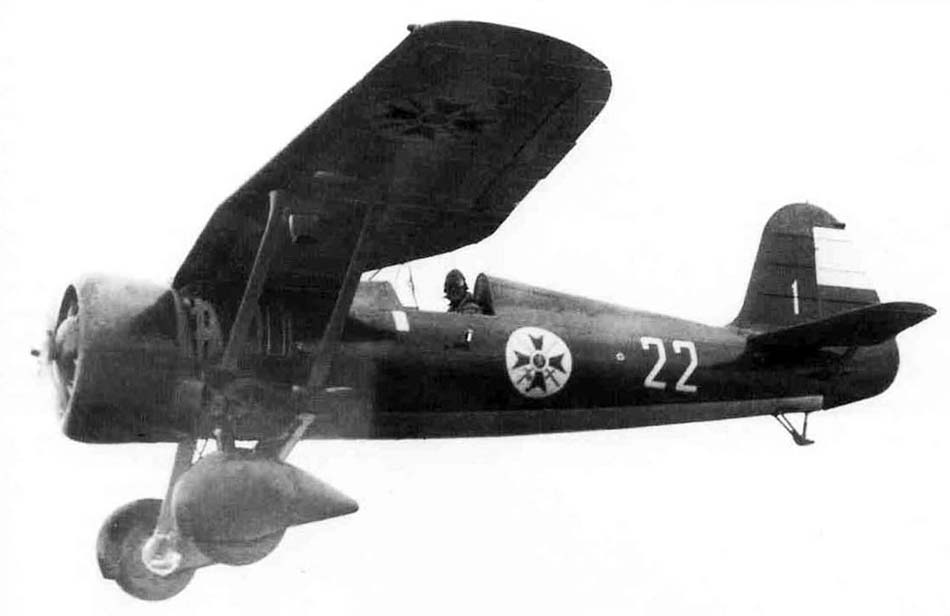PZL P.24 Fighter
PZL P.24 Overview
The PZL P.24 was a Polish-designed monoplane fighter developed in the mid-1930s by Państwowe Zakłady Lotnicze (PZL). It was a further development of the successful PZL P.11, fitted with the more powerful Gnome-Rhône radial engine. Unlike the P.11, which was primarily for Polish service, the P.24 was specifically intended for export, as licensing restrictions on the British Bristol Pegasus engine (used in the P.11) prevented its sale abroad.
The P.24 featured a gull-wing configuration, open cockpit, fixed undercarriage, and was heavily armed for its time, with versions carrying 2–4 machine guns or 2 machine guns plus 2 × 20 mm cannon. It proved attractive to countries seeking to modernise their fighter fleets in the late 1930s. Although never operated by Poland itself, it became one of the most widely exported Polish aircraft prior to the Second World War.
In Bulgarian Service
Bulgaria purchased 14 PZL P.24B fighters in 1937. Bulgaria placed a repeat order for 20 PZL P.24C, to be delivered by the end of 1938. It later ordered 26 PZL P.24Fs, 22 of which were delivered from Poland in July 1939, just before the outbreak of World War II. The remaining four, lacking propellers, were bombed in the Okęcie factory in September 1939 by the Germans.
The P.24s formed part of Bulgaria’s effort to re-establish a capable air force after the restrictions imposed by the Treaty of Neuilly. They were employed primarily as frontline fighters in the late 1930s and early war years, tasked with air defence and patrol duties. Although Bulgaria did not take part in combat operations in the early stages of the war, the P.24s were used during Bulgaria’s entry into the Axis war effort in 1941 for defensive air patrols. By 1943, they were increasingly outdated against modern Allied aircraft and relegated to training and second-line duties. The last Bulgarian P.24s were withdrawn by 1944, when German-supplied Bf 109s had fully replaced them.

In Romanian Service
Romania was one of the earliest customers, purchasing six PZL P.24E fighters in 1937 as well as a production license and built 25 E version aircraft in Romania under the local designation IAR P.24P.
The P.24Es were armed with 2 × 20 mm cannons and 2 × 7.92 mm machine guns, making them a powerful component of the Forțele Aeriene Regale ale României (Royal Romanian Air Force). They served as Romania’s frontline fighter during the late 1930s and were still in service when Romania joined the Axis invasion of the Soviet Union in June 1941. Romanian P.24s provided air defence around Bucharest and the Ploieşti oilfields from attacks by Soviet bombers. P.24 fighters reportedly managed to shoot down 37 VVS bombers, which were typically unescorted and thereby more vulnerable to interception. The P.24E was also routinely used for ground attack missions until the end of 1941; however, after 1942, the type was relegated to training duties. They were phased out completely by 1943–44, replaced by more modern German and Romanian-built aircraft.

In Greek Service
Greece purchased 30 PZL P.24F and 6 PZL P.24G fighters between 1938 and 1939. Although a production licence was purchased, only one P.24F was completed. The P.24F was armed with 2 × 20 mm cannons and 2 × 7.92 mm machine guns, while the P.24G carried 4 × 7.92 mm machine guns.
When Italy invaded Greece in October 1940, the P.24s formed the backbone of the Royal Hellenic Air Force. Despite being outclassed in speed by Italian Macchi C.200s and Fiat G.50s, Greek pilots achieved considerable success, exploiting the P.24’s manoeuvrability and heavy cannon armament. P.24s flew both interception missions and ground attack sorties during the Greco-Italian War.
When Germany launched its invasion of Greece in April 1941, the P.24s fought against overwhelming odds. Many were destroyed on the ground, but a number of aerial victories were scored against the Luftwaffe. By the end of the Balkan campaign, virtually all Greek P.24s had been destroyed, either in combat or by retreating crews to prevent capture.

In Turkish Service
Turkey was the first and largest customer for the P.24, ordering 14 P.24A and 26 P.24Cs which were delivered by 1937. Turkish aviation company Kayseri Tayyare Fabrikası (KTF) built an additional 20 P.24A/C variants and 20 P.24G fighters.
The P.24s served as Turkey’s primary fighter force in the late 1930s and early 1940s. As Turkey remained neutral for most of the war, the aircraft did not see combat against foreign powers, though they were used intensively for air defence patrols, training, and exercises.
By the early 1940s, the P.24 was obsolete, and Turkey began to receive more modern aircraft through Allied and Axis channels. The last Turkish P.24s were retired around 1943 with the last one leaving service in 1945.

